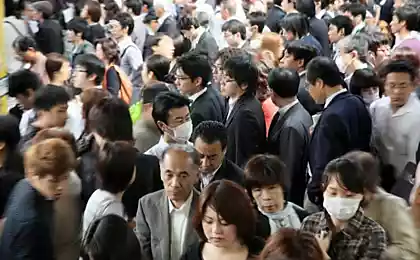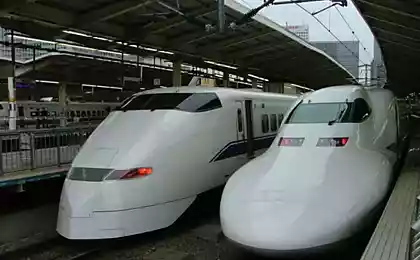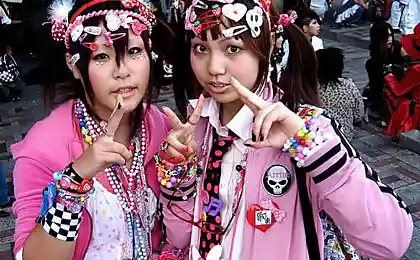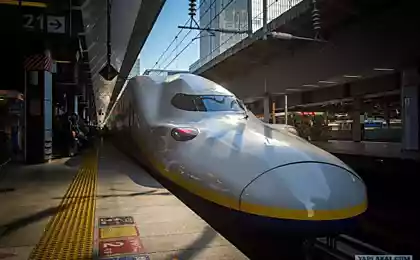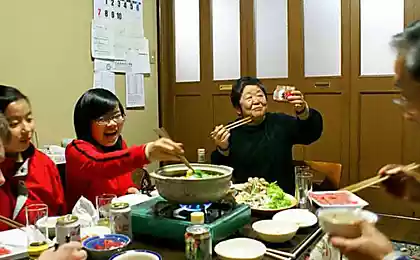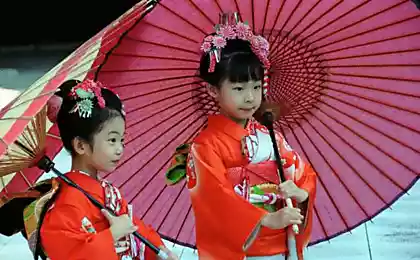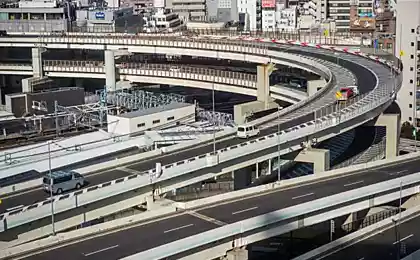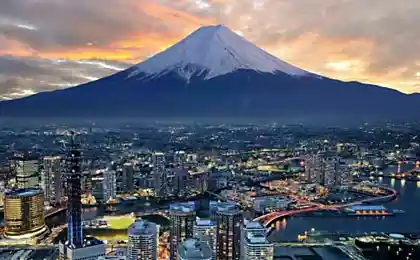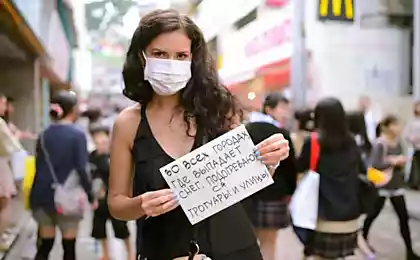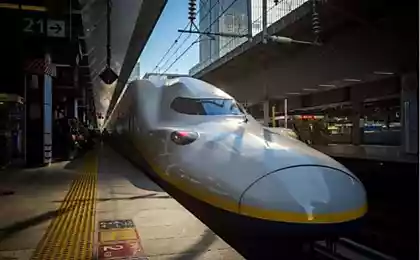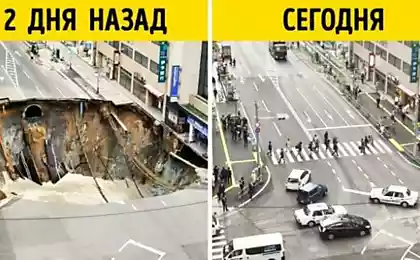1041
Difficult situation in Japan
In Japan, only for the last day (March 18 began in Tokyo at 18:00 MSK) was more than 20 aftershocks of earthquakes with magnitude of 4, 5 and 6, 1. All the tremors were centered off the eastern coast of the main Japanese island of Honshu, ie in the the area where the March 11 was the most powerful in the country's history, an earthquake of magnitude 9.
According to the police department of Japan at 16:00 MSK, confirmed the death of almost 5, 7 thousand. Man as a result of disaster strikes. More than 9, 5 thousand. People unaccounted for. Thus, the possible death toll could exceed 15 thousand. Man.
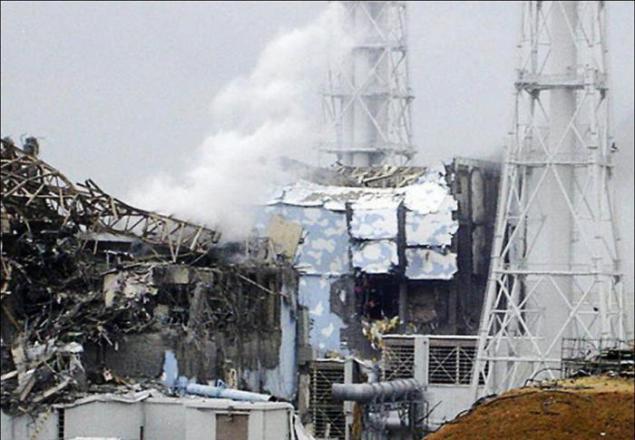
1. Fukushima, March 16 - As a result of explosions on the first and third power nuclear power plant "Fukushima-1" in Japan have suffered 23 people and two others were missing. As reported on March 17, the radiation level around the office building "Fukushima-1" has increased from 3,700 to 4,000 microsieverts per hour after trying to cool the reactor with water. The radiation level in the area of the building, which are working, rose to the level of 3000 microsieverts per hour as of 10:00 am local time. (AP) 2. In this image made 13 and published on March 14 tsunami washed away seen a house that is drifting in the waters of the Pacific Ocean off the coast of Japan. Japanese authorities offer to temporarily close the stock exchanges of the country and to suspend trading in the market Forex. With relevant proposals made by March 17 representatives of the upper house of Japan's parliament. (REUTERS / US Navy / Mass Communication Specialist 3rd Class Dylan McCord)

3. Truck hanging from the damaged bridge in Ishinomaki in northern Japan. The devastating earthquake, subsequent tsunami and events at the plant "Fukushima" could cost the Japanese economy. According to preliminary estimates of experts, the third largest economy in the world because of the disaster strikes may be short of $ 200 billion. (AP Photo / The Yomiuri Shimbun, Hiroshi Adachi
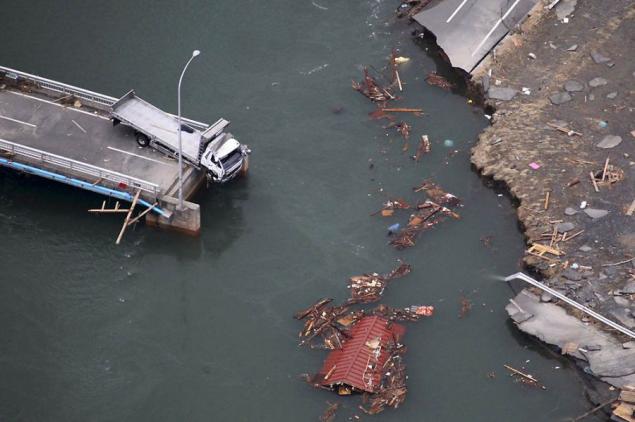
4. The girl on the background wall in the center of Seoul, where people leave messages and wishes to victims of the horrific impact of elements on the Land of the Rising Sun. Foreign experts on nuclear energy, the Japanese press and increasingly irritated and angered the Japanese public are unhappy that the government and the company were unable to clearly, clearly and without delay inform the public about the nuclear crisis. Pointing to conflicting reports, ambiguous statements and constant reluctance to confirm the obvious facts, they suspect the leadership of concealing or embellishment important information about the risks posed by damaged nuclear power plant "Fukushima-1". (REUTERS / Truth Leem)
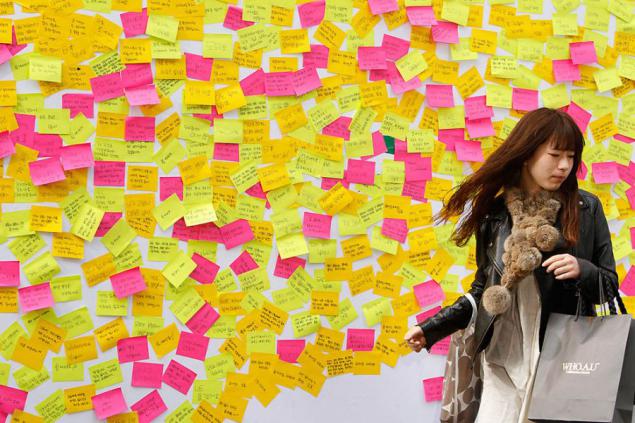
5. trash and debris after the tsunami in Sendai. (STR / AFP / Getty Images)

6. The bodies of those killed in one of the villages in Iwate prefecture on March 15. (REUTERS / Toru Hanai)
7. Cars ride through the city on March 15 Minamisankiru in northeastern Japan, which flattened element. (AP Photo / David Guttenfelder)
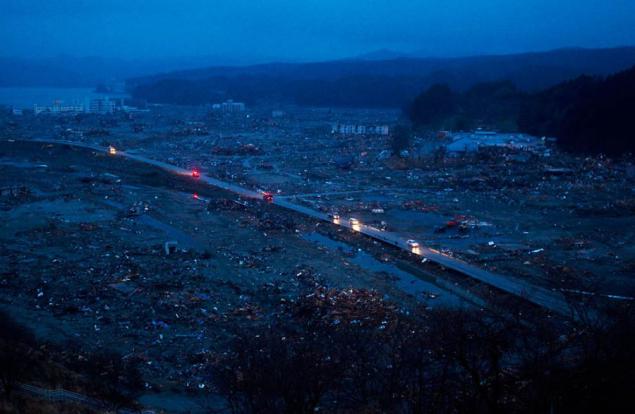
8. A general view of Tokyo at night, which due to the energy crisis in the country are power outages. (Adam Pretty / Getty Images)

9. An employee of the company «Tokyo Electric Co.» shows a picture of one of the destroyed unit "Fukushima" at a press conference in Tokyo on March 16, 2011. About 70,000 residents have been evacuated from the 20-kilometer zone around the plant, and another 140 thousand within a radius of 35 kilometers were told not to leave the house. Several camps were evacuated to safe places equipped in Fukushima Prefecture. (AP Photo / Eugene Hoshiko)
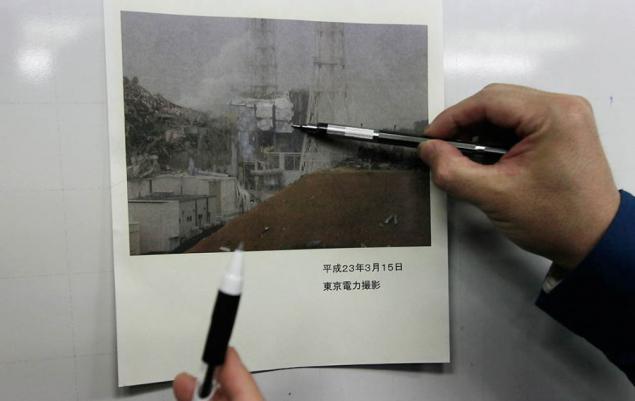
10. Empty shelves in a supermarket Moriyama March 15, 2011. (AP Photo / Mark Baker)
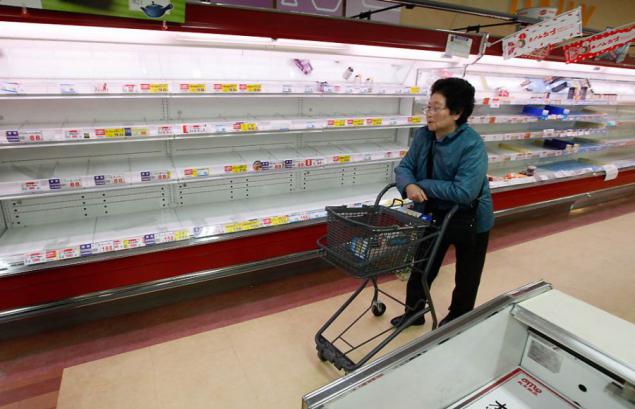
11. Rescuers work in Otsuchi, one of the areas affected by the disaster. In this Japanese city located in Iwate Prefecture, the tsunami came at the height of the working day, demolished City Hall together with the mayor and all city government. (REUTERS / Aly Song)
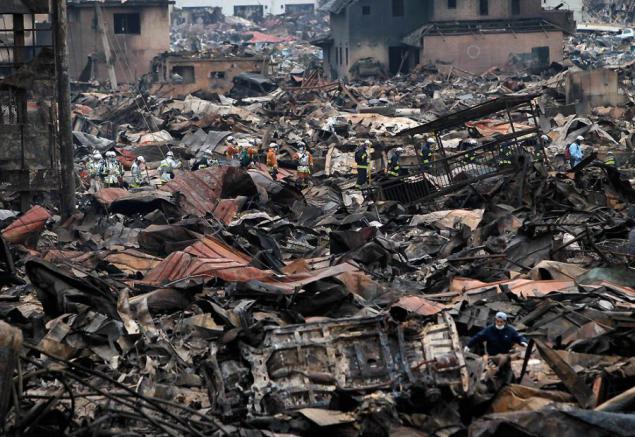
12. Search and rescue teams from the UK working in the Japanese city of Kamaishi on March 16, 2011. According to the official website of Ministry of the Russian Federation, from March 15 in Sendai are 79 Russian rescuers. March 16 in Japan flew two more Russian Emergencies Ministry aircraft - AN-74 and IL-76 - with rescuers and an expert group of "Rosatom" on board. "In total 82 people, four pieces of equipment, search and rescue equipment. Both aircraft landed at Narita Airport "- said in a press release. Thus, a team of Russian rescuers in Japan amounted to 161 people - at the moment it is the largest foreign group. Russia provides such assistance to Japan for the first time in history. (AP Photo / Matt Dunham)
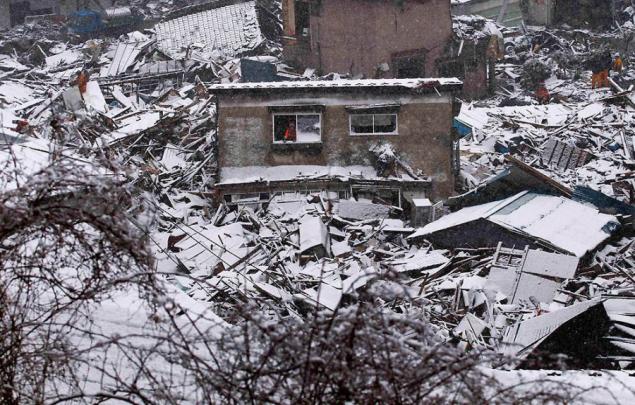
13. Representatives of the Japanese self-defense forces under the thick snow in the residential area of Otsuchi March 16. (REUTERS / Damir Sagolj)
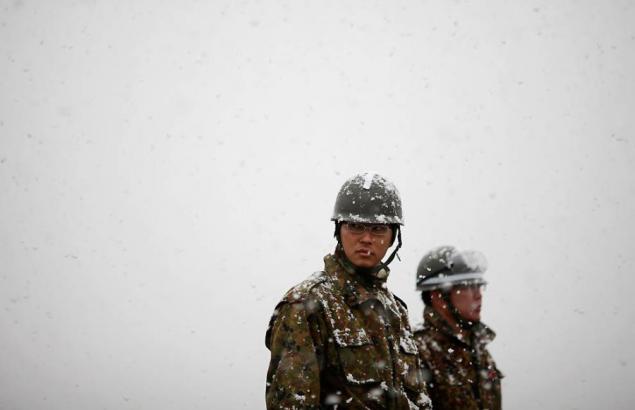
14. A copy of the statue of liberty among the ruins in the city of Ishinomaki, Miyagi Prefecture. (KIM JAE-HWAN / AFP / Getty Images)

15. Tea is brewed in a traditional Japanese teapot. The picture was taken on March 15 in the center for evacuees in Otsuchi. (REUTERS / Damir Sagolj)

16. Kiyomi Kimura tearfully hugging her daughter in the shelter of the city of Ishinomaki, Miyagi Prefecture March 15. They finally met for the first time after the earthquake in Japan. (JIJI PRESS / AFP / Getty Images)

17. break through and glove worn on the hand of one of the rescuers in the devastated city of Sendai, Miyagi Prefecture March 14. (STR / AFP / Getty Images)
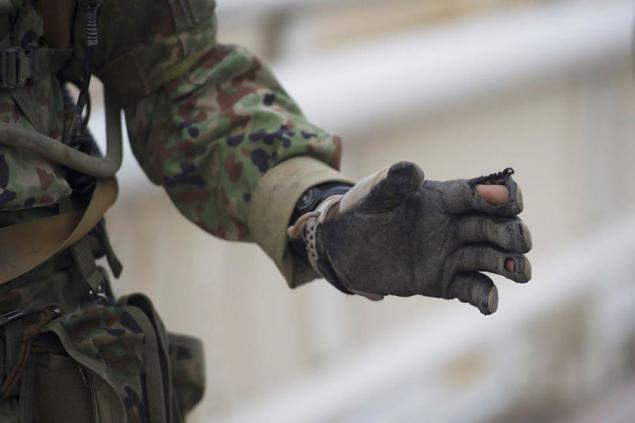
18. Women rescue ship charred body in the truck. The picture was taken in the devastated by the earthquake, tsunami and fires the city of Kesennuma. (Paula Bronstein / Getty Images

19. The view from the cockpit of American aircraft at the airport of the city of Sendai. (REUTERS / US Air Force / Staff Sgt. Samuel Morse)

20. The average American civilian and military transport helicopter «CH-46E Sea Knight» with a squadron of helicopters average MP 265 landed on an improvised landing zone in Sendai. (REUTERS / US Marine Corps / Gunnery Sgt. Leo A. Salinas)

21. An elderly Japanese man in the center for homeless over his head in Koriyama. (AP Photo / Gregory Bull)
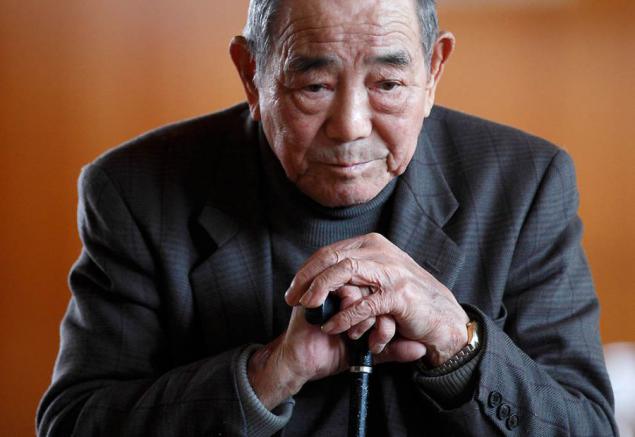
22. Police found the bodies spread among the debris in the port city Rikunzetakata. Before the tsunami, the city was home to 24 thousand people. After the huge wave destroyed the whole city, 18,000 of its citizens were missing. (REUTERS / Adrees Latif)
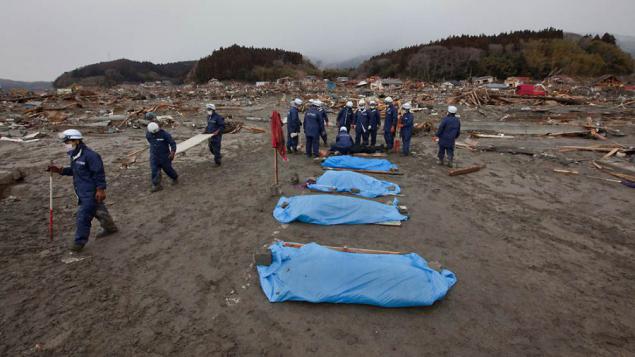
23. Five days after the devastating earthquake on March 16 left homeless residents of the city gathered around a campfire Otsuchi and read newspapers. (AP Photo / Yomiuri Shimbun, Yoichi Hayashi)
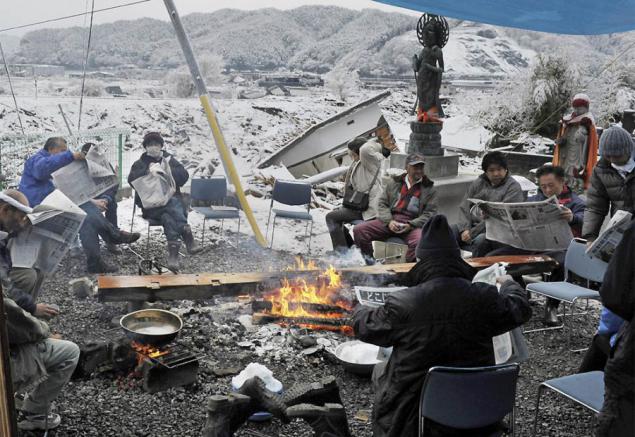
24. One representative defense forces found in the ruins of an apartment building in Otsuchi someone's family album. (REUTERS / Damir Sagolj)

25. A local resident on a background of ruins in the city of Minami Sanriku, which was destroyed by a seismic wave last week. As a result of the tragedy in Minami Sanriku, about half of the 17, 5 thousand residents missing. (REUTERS / Jo Yong-Hak)
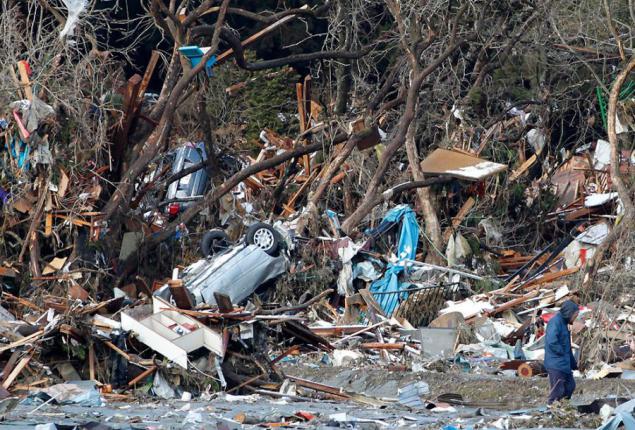
26. Japanese Self-Defense Forces in the residential area of Otsuchi in Miyagi Prefecture. (REUTERS / Damir Sagolj)
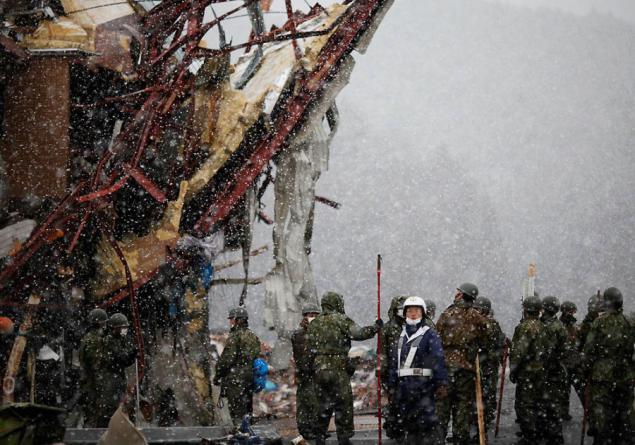
27. Neighborhood "Fukushima-1": the owner with his dog waiting for checks on the level of radiation exposure on March 16. (AP Photo / Gregory Bull)

28. The interior of classroom in elementary school in Otsuchi. (AP Photo / Tokyo Shimbun, Masahiro Kawayanagi)
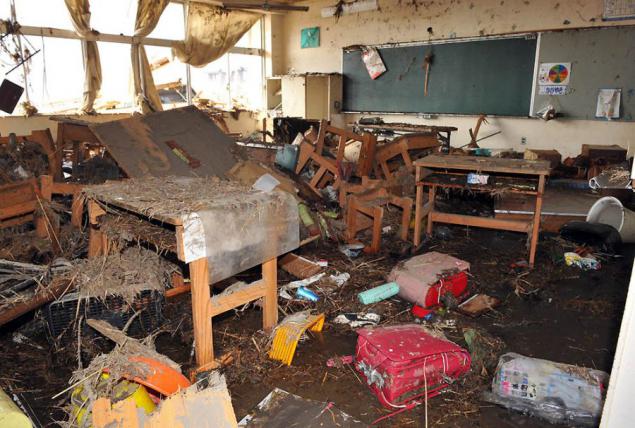
29. sobbed the woman holding the hand of his dead mother, buried under the rubble in the city Rikunzetakata. (REUTERS / Kyodo)
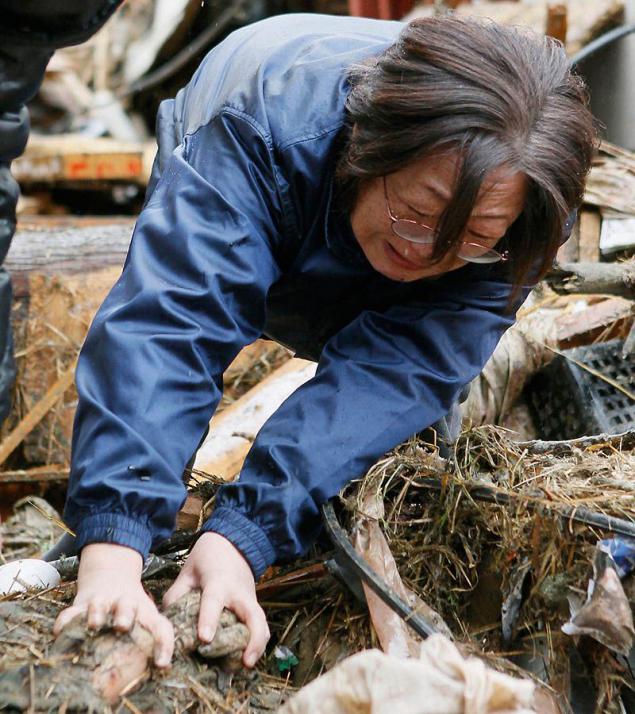
30. Despite the fact that since the strongest earthquake has been five days in the city of Kesennuma fires continue. (REUTERS / Adrees Latif)
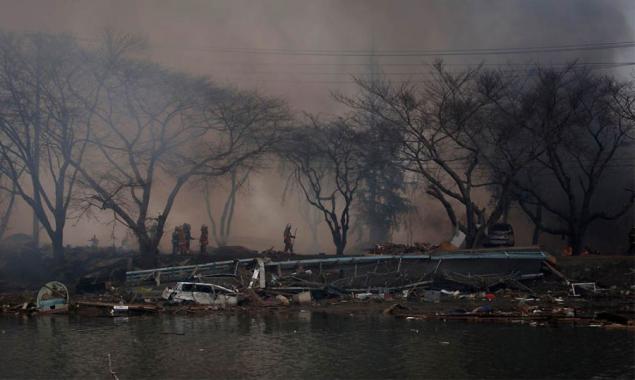
31. In the middle of the river that runs in Kesennuma, is home. (REUTERS / Adrees Latif)
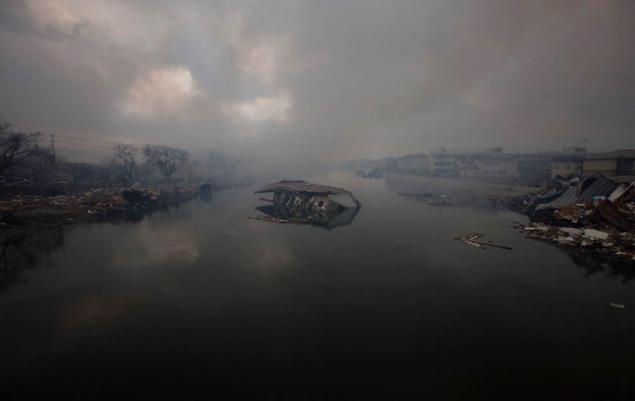
32. Yuki Ito calms her 8-year-old daughter Hana cold refugee center in the city of Kesennuma. (Paula Bronstein / Getty Images)

According to the police department of Japan at 16:00 MSK, confirmed the death of almost 5, 7 thousand. Man as a result of disaster strikes. More than 9, 5 thousand. People unaccounted for. Thus, the possible death toll could exceed 15 thousand. Man.

1. Fukushima, March 16 - As a result of explosions on the first and third power nuclear power plant "Fukushima-1" in Japan have suffered 23 people and two others were missing. As reported on March 17, the radiation level around the office building "Fukushima-1" has increased from 3,700 to 4,000 microsieverts per hour after trying to cool the reactor with water. The radiation level in the area of the building, which are working, rose to the level of 3000 microsieverts per hour as of 10:00 am local time. (AP) 2. In this image made 13 and published on March 14 tsunami washed away seen a house that is drifting in the waters of the Pacific Ocean off the coast of Japan. Japanese authorities offer to temporarily close the stock exchanges of the country and to suspend trading in the market Forex. With relevant proposals made by March 17 representatives of the upper house of Japan's parliament. (REUTERS / US Navy / Mass Communication Specialist 3rd Class Dylan McCord)

3. Truck hanging from the damaged bridge in Ishinomaki in northern Japan. The devastating earthquake, subsequent tsunami and events at the plant "Fukushima" could cost the Japanese economy. According to preliminary estimates of experts, the third largest economy in the world because of the disaster strikes may be short of $ 200 billion. (AP Photo / The Yomiuri Shimbun, Hiroshi Adachi

4. The girl on the background wall in the center of Seoul, where people leave messages and wishes to victims of the horrific impact of elements on the Land of the Rising Sun. Foreign experts on nuclear energy, the Japanese press and increasingly irritated and angered the Japanese public are unhappy that the government and the company were unable to clearly, clearly and without delay inform the public about the nuclear crisis. Pointing to conflicting reports, ambiguous statements and constant reluctance to confirm the obvious facts, they suspect the leadership of concealing or embellishment important information about the risks posed by damaged nuclear power plant "Fukushima-1". (REUTERS / Truth Leem)

5. trash and debris after the tsunami in Sendai. (STR / AFP / Getty Images)

6. The bodies of those killed in one of the villages in Iwate prefecture on March 15. (REUTERS / Toru Hanai)
7. Cars ride through the city on March 15 Minamisankiru in northeastern Japan, which flattened element. (AP Photo / David Guttenfelder)

8. A general view of Tokyo at night, which due to the energy crisis in the country are power outages. (Adam Pretty / Getty Images)

9. An employee of the company «Tokyo Electric Co.» shows a picture of one of the destroyed unit "Fukushima" at a press conference in Tokyo on March 16, 2011. About 70,000 residents have been evacuated from the 20-kilometer zone around the plant, and another 140 thousand within a radius of 35 kilometers were told not to leave the house. Several camps were evacuated to safe places equipped in Fukushima Prefecture. (AP Photo / Eugene Hoshiko)

10. Empty shelves in a supermarket Moriyama March 15, 2011. (AP Photo / Mark Baker)

11. Rescuers work in Otsuchi, one of the areas affected by the disaster. In this Japanese city located in Iwate Prefecture, the tsunami came at the height of the working day, demolished City Hall together with the mayor and all city government. (REUTERS / Aly Song)

12. Search and rescue teams from the UK working in the Japanese city of Kamaishi on March 16, 2011. According to the official website of Ministry of the Russian Federation, from March 15 in Sendai are 79 Russian rescuers. March 16 in Japan flew two more Russian Emergencies Ministry aircraft - AN-74 and IL-76 - with rescuers and an expert group of "Rosatom" on board. "In total 82 people, four pieces of equipment, search and rescue equipment. Both aircraft landed at Narita Airport "- said in a press release. Thus, a team of Russian rescuers in Japan amounted to 161 people - at the moment it is the largest foreign group. Russia provides such assistance to Japan for the first time in history. (AP Photo / Matt Dunham)

13. Representatives of the Japanese self-defense forces under the thick snow in the residential area of Otsuchi March 16. (REUTERS / Damir Sagolj)

14. A copy of the statue of liberty among the ruins in the city of Ishinomaki, Miyagi Prefecture. (KIM JAE-HWAN / AFP / Getty Images)

15. Tea is brewed in a traditional Japanese teapot. The picture was taken on March 15 in the center for evacuees in Otsuchi. (REUTERS / Damir Sagolj)

16. Kiyomi Kimura tearfully hugging her daughter in the shelter of the city of Ishinomaki, Miyagi Prefecture March 15. They finally met for the first time after the earthquake in Japan. (JIJI PRESS / AFP / Getty Images)

17. break through and glove worn on the hand of one of the rescuers in the devastated city of Sendai, Miyagi Prefecture March 14. (STR / AFP / Getty Images)

18. Women rescue ship charred body in the truck. The picture was taken in the devastated by the earthquake, tsunami and fires the city of Kesennuma. (Paula Bronstein / Getty Images

19. The view from the cockpit of American aircraft at the airport of the city of Sendai. (REUTERS / US Air Force / Staff Sgt. Samuel Morse)

20. The average American civilian and military transport helicopter «CH-46E Sea Knight» with a squadron of helicopters average MP 265 landed on an improvised landing zone in Sendai. (REUTERS / US Marine Corps / Gunnery Sgt. Leo A. Salinas)

21. An elderly Japanese man in the center for homeless over his head in Koriyama. (AP Photo / Gregory Bull)

22. Police found the bodies spread among the debris in the port city Rikunzetakata. Before the tsunami, the city was home to 24 thousand people. After the huge wave destroyed the whole city, 18,000 of its citizens were missing. (REUTERS / Adrees Latif)

23. Five days after the devastating earthquake on March 16 left homeless residents of the city gathered around a campfire Otsuchi and read newspapers. (AP Photo / Yomiuri Shimbun, Yoichi Hayashi)

24. One representative defense forces found in the ruins of an apartment building in Otsuchi someone's family album. (REUTERS / Damir Sagolj)

25. A local resident on a background of ruins in the city of Minami Sanriku, which was destroyed by a seismic wave last week. As a result of the tragedy in Minami Sanriku, about half of the 17, 5 thousand residents missing. (REUTERS / Jo Yong-Hak)

26. Japanese Self-Defense Forces in the residential area of Otsuchi in Miyagi Prefecture. (REUTERS / Damir Sagolj)

27. Neighborhood "Fukushima-1": the owner with his dog waiting for checks on the level of radiation exposure on March 16. (AP Photo / Gregory Bull)

28. The interior of classroom in elementary school in Otsuchi. (AP Photo / Tokyo Shimbun, Masahiro Kawayanagi)

29. sobbed the woman holding the hand of his dead mother, buried under the rubble in the city Rikunzetakata. (REUTERS / Kyodo)

30. Despite the fact that since the strongest earthquake has been five days in the city of Kesennuma fires continue. (REUTERS / Adrees Latif)

31. In the middle of the river that runs in Kesennuma, is home. (REUTERS / Adrees Latif)

32. Yuki Ito calms her 8-year-old daughter Hana cold refugee center in the city of Kesennuma. (Paula Bronstein / Getty Images)



